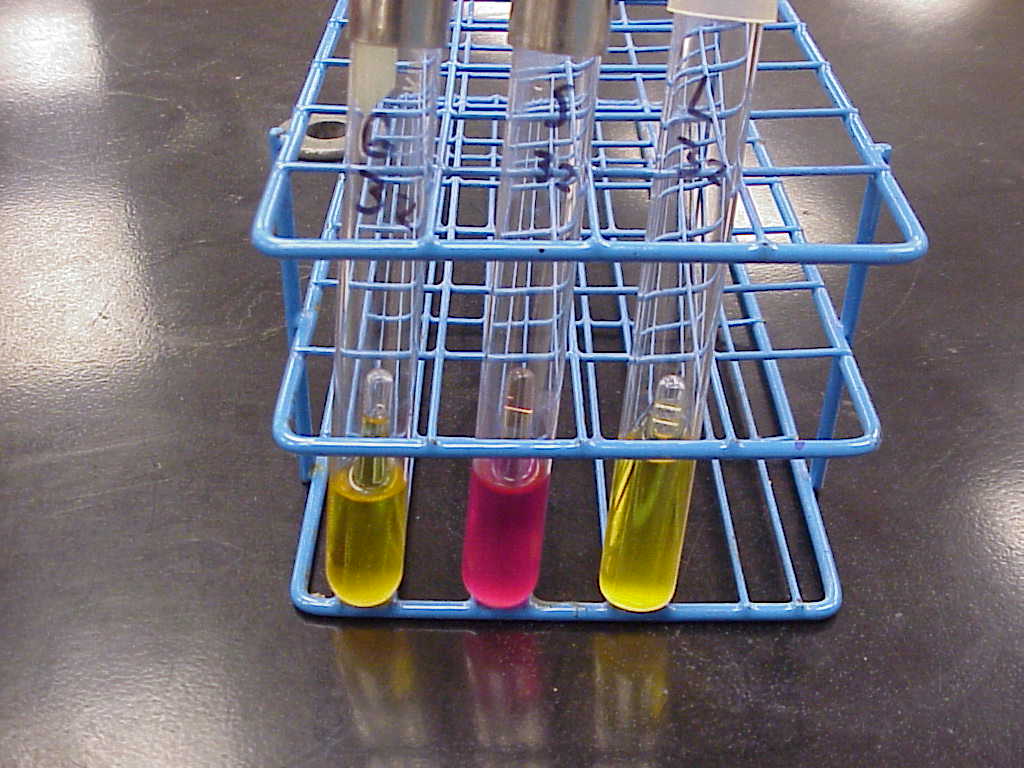Introduction
The different types of sugars used in fermentation had a significant impact on the amount of carbon dioxide produced. Glucose produced the most with a gas bubble of 132mm while sucrose yielded 102mm of carbon dioxide.
Method
The gas by-product in fructose measured only 56mm. The control with no sugar resulted in 0mm of carbon dioxide and was the least productive of the tubes. The slope of the line of best fit was analyzed to determine the average rate of carbon dioxide production over the 20 minute time frame.
Glucose was the most efficient, producing 12.64 mm of carbon dioxide per minute. Sucrose yielded 9.27 mm of carbon dioxide per minute during fermentation while fructose functioned at a rate of 3.99 mm of carbon dioxide per minute. The control that contained no sugar had no rate of carbon dioxide production.
The rate of production of carbon dioxide for both glucose and sucrose remained fairly constant throughout the experiment. The rate for fructose began slowly but increased rapidly as time went on. The rate of production of carbon dioxide remained at a constant 0 throughout.
Discussion & Explanation
The hypothesis was supported in that all forms of sugar produced energy and that glucose was the most efficient.
The carbon dioxide produced can be directly related to the energy produced through fermentation because carbon dioxide is a by-product of ethanol fermentation (Cellular, 54). The control that contained no sugar produced no energy because a source of sugar is required for glycolysis and fermentation to occur.
Glucose had the greatest rate of energy production because its rate of carbon dioxide production was the largest. Sucrose had the second-highest rate of production while fructose had the lowest rate out of the three sugars. Glucose’s rate of energy production was more than three times that of fructose.
Glucose was directly used in the glycolysis cycle and did not require any extra energy to convert it into a usable form (Freeman, 154). This supported why glucose was the most efficient.
Sucrose required an enzyme and energy input to break it down into glucose and fructose in order for it to be processed in glycolysis (Freeman, 189). Fructose also could not be used immediately in the glycolysis chain but had to be altered to enter the chain as one of the intermediates (Berg, 2002).
These processes required to convert the non-glucose sugars into a usable form reduced their efficiency when compared to glucose. The largest source of error for the experiment was the start time of fermentation. The yeast was added to the fructose solution well after the glucose and fructose yeast solutions began fermenting.
Fermentation takes time to reach its maximum rate of energy production so the time gap left glucose and sucrose further ahead than fructose in the fermentation process (Berg, 2002). The data on the rate of carbon dioxide production was therefore skewed because the start of fermentation was not controlled.
Glucose and sucrose appear far more efficient than fructose because of this error. If this experiment were to be repeated, extra care would be taken to ensure that fermentation began at the same time. The measurements of sugars would be measured in equal molarity and not by percent in a solution so that the sugar molecules are equal across all of the tests.
Other follow-up experiments may include testing other types of yeasts to see how fermentation rates are impacted. The results of these experiments could impact what sugars are the most efficient in alcohol fermentation. This could determine what types of sugar brewers should use for the most efficient production of alcohol.


Berg et al., 2002
J.M. Berg, J.L. Tymoczko, L. Stryer
Glycolysis is an energy-conversion pathway in many organisms
Biochemistry, W H Freeman, New York (2002)
is there a works cited page for this
Thanks this website was very helpful for my chemistry EEI 🙂
IS there anyway to see the works cited? I’m interested reading Freeman
were you able to find the source?
thanks so much, this helped a ton with my Bio EEI
Great article/investigation,
Very imforative though it’s a shame it was written in 1st person as science EEI’s are generally meant to be written in 3rd person.
But overall great job
It’s actually written in the correct form for that, because it is passive voice and past tense.